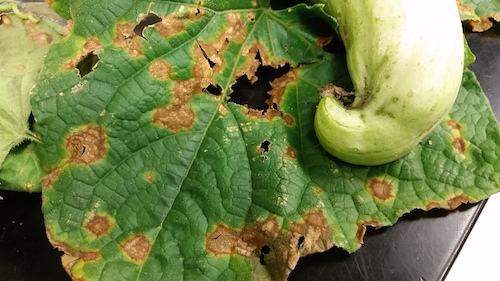Anthracnose and Alternaria leaf blights are showing up in cucurbit crops. Weather conditions in the region continue to be ideal for disease development across all vegetable crops. The regular rainfall and high humidity that have plagued the region only acts to exacerbate problems. All cucurbit growers should be on high alert for foliar diseases such as anthracnose and Alternaria as well as downy mildew. Anthracnose and Alternaria produce distinct circular spots on infected leaves, and in most cases, symptoms begin on the older leaves.
With Alternaria, diagnostic concentric black rings will be develop within the spots. With Anthracnose, black setae (hair-like projections) will develop on the veins of infected tissue on the underside of leaves.
Anthracnose and Alternaria are easily controlled with weekly protectant fungicides such as chlorothalonil and mancozeb as long as they are applied prior to the arrival of the pathogen. Control of downy mildew will require downy mildew specific fungicides. As long as these weather conditions persist all growers need to remain on strict weekly protectant fungicide programs and be scouting on a daily basis. Organic growers can apply copper and other labeled products to help suppress development of these diseases.
Complete foliar coverage is critically important for the control these diseases.
For more information on the control of anthracnose and Alternaria leaf blight in cucurbit crops please see the 2015 Commercial Vegetable Production Guide.


